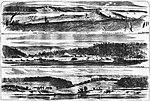Saint John Paul the Great Catholic High School
2008 establishments in VirginiaCatholic secondary schools in VirginiaDominican schools in the United StatesEducational institutions established in 2008Roman Catholic Diocese of Arlington ... and 2 more
Schools in Prince William County, VirginiaUse mdy dates from December 2023
Saint John Paul the Great Catholic High School is a private, college preparatory, coeducational Catholic high school in Dumfries, Virginia led by the Dominican Sisters of St. Cecilia. As a diocesan school of the Diocese of Arlington, it is accredited by the Southern Association of Colleges and Schools. In 2012 it was included in the Cardinal Newman Society's Top 50 Catholic High Schools list. It was placed on the list again in 2014.In 2013 it was chosen by the editors of Virginia Living magazine as a 2013 Top Virginia School.
Excerpt from the Wikipedia article Saint John Paul the Great Catholic High School (License: CC BY-SA 3.0, Authors).Saint John Paul the Great Catholic High School
Woods View Drive,
Geographical coordinates (GPS) Address Nearby Places Show on map
Geographical coordinates (GPS)
| Latitude | Longitude |
|---|---|
| N 38.566666666667 ° | E -77.2875 ° |
Address
Woods View Drive
22026
Virginia, United States
Open on Google Maps





